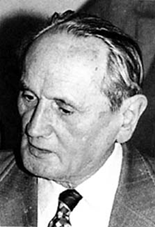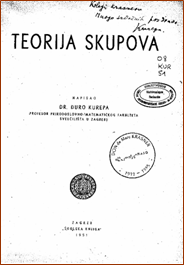 The website is in construction. New files will be uploaded as soon as they are available.
The website is in construction. New files will be uploaded as soon as they are available.
ÐURO KUREPA
Majske Poljane 1907 - Belgrade 1993

- Brief scientific biography
- His Commitment to Education
- Essential secondary bibliography
- Articles on teaching of mathematics
Brief scientific biography
Ð Kurepa was born on August 16, 1907 at Majske Poljane (a town in today's Croatia), being the fourteenth child in his father's family. He studied pure mathematics and physics at the University of Zagreb, where he graduated in 1931.
In 1932, Kurepa entered Collège de France, where his guide and maitre was the outstanding French mathematician M. Fréchet. From the beginning of his stay in Paris, Kurepa focused his attention on the famous Suslin's problem, which asks for a particular characterization of the real line. He introduced some special classes of partially ordered sets and used them to formulate several statements equivalent to Suslin's hypothesis. In 1935, at the Sorbonne, he defended his doctoral thesis, Ensembles ordonnés et ramifiés, before a committee consisting of P. Montel as president, M. Fréchet as supervisor, and A. Denjoy as its third member.

During the latter parts of his scientific life, Kurepa turned his attention towards other areas of mathematics, most notably algebra and number theory. In 1971 Kurepa made a particularly significant contribution in number theory with the introduction of the left factorial function. In the discrete case, it is defined by !n = 0! + 1! + 2! + ... + (n - 1)!. He conjectured that the greatest common divisor of !n and n! is 2, for each n > 1, and this conjecture became quite famous. Checked first up to n=100000 (see (CONNOR and ROBERTSON, 2006), this hypothesis was recently proved by Barsky and Benzaghou (BARSKY and BENZAGHOU, 2004).
Kurepa was a professor at the University of Zagreb from 1937 to 1965 and at the University of Belgrade from 1965 until his retirement in 1977. He frequently visited high ranking scientific institutions in France. He also spent half a year as a member of the Institute for Advanced Study in Princeton. He also visited and delivered lectures at many other institutions in the world, including University of Warsaw, Harvard University, University of Chicago, Universities of California at Berkeley and at Los Angeles.

Being a Serb born in Croatia, Ð Kurepa lived through all the tragic South Slav's conflicts, always believing in reconciliation as the only way to the future. Good-natured as he was, he left this world on November 2, 1993.
His Commitment to Education
As the representative of Yugoslavia, Ð Kurepa attended the First IMU General Assembly (Rome, 1952), when ICMI was reconstituted and when the new ICMI Executive Committee was formed: A. Chatelet (France), president, Ð. Kurepa (Yugoslavia), vice-president, R. L. Jeffery (Canada), vice-president and V. Behnke (Germany), secretary (including H. Fehr as a life-long honorary president). At the first meeting of ICMI Commission (Geneva, Oct. 1952), as a plan of work scheduled for the coming IMU Congress, Amsterdam 1954, two main themes were fixed, one of which, The Role of Mathematics and Mathematician at the Present Time, was entirely assigned to Kurepa for elaboration. He conducted an international poll on this theme and elaboration of it was assessed as very satisfactory at the Amsterdam Congress (Kurepa's reports at the II Congress of Mathematicians and Physicists of Yugoslavia, Zagreb, 1954 as well as KUREPA 1955).
Let us also single out a number of lines characteristic for his views on education (KUREPA 1959, Des principes de ...):
"L'enseignement est un processus dans lequel le milieu social, l'enseignant et l'enseigné s'influencent mutuellement ... A tous ses degrés l'enseignement doit être intimement lié aux efforts créateurs de la société et en particulier aux points de vue nouveaux et aux progrès des sciences."On the suggestion of and in cooperation with ICMI, an International Symposium on the Coordination of Instruction in Mathematics and Physics was held in Belgrade, Sept. 19 - 24, 1960. Following the Symposium, a book was published by Union of Societies of Mathematicians and Physicists of Yugoslavia, Belgrade 1962, containing all contributed papers (of G. Choquet, R. Courant, G. Frostman, Ð. Kurepa, P. Libois, G. Sansone, M. Stone et al.). On that occasion, Kurepa delivered a welcome speech and relating mathematics and physics; he said "... every phenomenon we encounter contains intrinsically something of mathematics and something of physics and is a vivid specimen of ties Mathematics - Physics." His contribution Some Principles on Coordination in the Instruction of Mathematics and Physics is split into sixteen paragraphs, each having a title suggesting main idea. Let us cite some of those titles that are also suggestive the depth of his considerations: Physics - Mathematics; Particular - General; Autonomy and Interdependence; Functional and Relational Standpoint as Link between Mathematics and Other Fields; Infinitesimal, Vectorial and Statistical Methods; Hierarchy of methods, Nature as a Whole and Mathematics as its Language; The Fundamental Tetrad: Action - Perception - Intelligence - Imagination.
"L'enseignement doit être actuel ... En particulier il vaut mieux faire ressortir les points de vue nouveaux et les applications que se perdre avec pédantisme dans les finesses logiques de démonstrations longues et complexes ... "
"Nous nous trouvons devant une reforme radicale de l'enseignement des mathématiques. Plus précisément ce sont les notions d'ensemble, de transformation et de structure qui doivent jouer un rôle actif dans l'enseignement."
Ð Kurepa was a man of wide-ranging mathematical knowledge with an evident aptitude for generalizations. He considered the concept of set to be basic at all levels of teaching and learning mathematics, but that the examples of sets should vary from sensory level (collections of isolated, concrete objects) going up to more complex abstractions (his paper Quelques aspects de l'importance de la théorie des ensembles, Glasnik Mat. Fiz. i Astr. t. 10, No 4, 1955).
Ð Kurepa is held in high regard by those who were his students. His lectures were very interesting, full of historical references and anecdotes and when proving theorems he touched only main details. When finishing a proof, he used to ask the audience "have you seen why the theorem holds true" and the audience would answer in one voice "yes, we have" (and only pedants thought it was proof by acclamation). At the end, let us say that the influence of Ð Kurepa on the development of mathematics and mathematical education was significant and great in all parts of the Former Yugoslavia.
Essential secondary bibliography
D. BARSKY et B. BENZAGHOU 2004, Nombres de Bell et somme de factorielles, Journal de Theorie des Nombres de Bordeaux, 16, 1-17.
H. BENKE 1951-1954, Commission Internationale de l'enseignement mathématique. Sa participation au Congrès d'Amsterdam 1954, Travaux préparatoires, L'Enseignement mathématique, 40, 72-74
P. COHEN 1963, The independence of the continuum hypothesis, Proc. Nat. Acad. Sci. U.S.A. 50, 1143-1148.
P. COHEN 1964, The independence of the continuum hypothesis, II. Proc. Nat. Acad. Sci. U.S.A. 51, 105--110.
J. COLMEZ 1947, Sur divers problèmes concernant les espaces topologiques, Portugaliae Math. 6, 119 - 244
M. Z. GRULOVIC 1995, The work of Professor Djuro Kurepa in the set theory and the number theory, Zb. Rad. Prirod.-Mat. Fak. Ser. Mat., 25 (1), 211-223
A. IVIC, Z. MAMUZIC, Z. MIJAJLOVIC, S. TODORCEVIC (eds.) 1996, Selected papers of Duro Kurepa, Matematicki Institut SANU, Belgrade, 1996
T. JECH 1967, Non-provability of Souslin's hypothesis, Comment. Math. Univ. Carolinae 8, 291--305.
V. KOVACEVIC-VUJCIC and Z. MIJAJLOVIC 1996, Symposium Dedicated to the Memory of Duro Kurepa : Papers from the International Mathematical Symposium held at the University of Belgrade, Belgrade, May 27-28, 1996, Sci. Rev. Ser. Sci. Eng. No., 19-20
J. J. O'CONNOR and E. F. ROBERTSON 2006, Duro Kurepa, http://turnbull.mcs.st-and.ac.uk/~history/Biographies/Kurepa.html
R. M. SOLOVAY, S. TENNENBAUM 1971, Iterated Cohen extensions and Souslin's problem, Ann. of Math. (2) 94, 201-245
S. TENNENBAUM 1968, Souslin's problem, Proc. Nat. Acad. Sci. U.S.A. 59, 60-63
Articles on teaching of mathematics
Ð. KUREPA 1955, Le rôle des mathématiques et du mathématicien à l'époque contemporaine, L'Enseignement Mathématique, II, 1, 93-111
Ð. KUREPA 1959, Scientific foundation of school mathematics, L'Enseignement Mathématique, II, 5, 196-202
Ð. KUREPA 1959, Des principes de l'enseignement mathématique, L'Enseignement Mathématique, II, 5, 203-212
Ð. KUREPA 1960, On the teaching of geometry in secondary schools, L'Enseignement Mathématique, II, 6, 69-80 and 313-320
Authors
Michela Malpangotto
SYRTE - Equipe des historiens
Observatoire de Paris
michela.malpangotto@obspm.fr
Milosav M. Marjanovic
Serbian Academy of Sciences and Arts
milomar@beotel.yu
Stevo Todorcevic
CNRS, Paris and University of Toronto
stevo@math.jussieu.fr, stevo@math.toronto.edu
